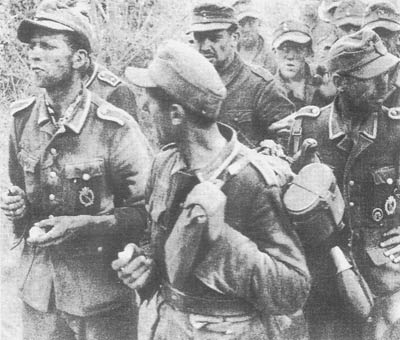In the spring of 1943, German forces were no longer the undisputed masters of the battlefield. In North Africa they were being pushed back into an enclave in Tunisia, facing defeat by the combined Allied forces, and in Russia they were on the back foot after Stalingrad. The battle of Stalingrad had been a resounding defeat for both the German 6 Army, which had been surrounded and subsequently surrendered, and for the German General Staff, which had seen the tide of war reversed, with the Russians beginning an offensive in November 1942 which was to end in Berlin in May 1945.
However, the quality of the German soldier was to have a significant effect on the Russian front. The fighting qualities which were so obvious in the advance and in Blitzkrieg were to be equally valuable in the fighting retreat which the Germans conducted over the whole of the eastern front in the two years it took the Russians to reach the German capital.
Basic training in Germany always emphasised the need for rehearsal and practice, and although the training period was shortened as the situation grew worse, the German soldier proved himself adept at fighting the interminably long rearguard action. In Germany efforts were continually being made to try to stem the Russian advance, but the sheer size of the Russian Army and its never-ending reserves of manpower, coupled with its growing expertise, made the final result inevitable.
Improved weaponry was seen by the Germans as one way of making up for the manpower shortages becoming increasingly apparent in the German Army. The MG42 machine gun was a great improvement on the MG34, having far fewer stoppages due to dust and dirt, and in the winter the use of sunflower oil also reduced the freezing-up of this and other weapons. A significant step forward was also made in rifle technology: the appearance of Russian semi-automatic and self-loading rifles resulted in experiments which eventually produced the MP44. This rifle fired a practical battlefield round, was semi-automatic, and had a 30-round magazine. Unfortunately for the average Landser, issue was more often than not to the Waffen-SS troops rather than to line infantry, and the Kar 98k was still the standard rifle for most infantrymen.
Support weapons were little modified in themselves, but some units benefited from the development of the assault gun (Sturmgeschutz), tracked guns which were sometimes also armoured. These guns were issued as a substitute for the more complicated tanks, and as support artillery they were of great value in the field. Some versions were fitted with anti-tank guns – such weapons were singularly useful against the mass tank attacks of the Russians, as long as they were supported by infantry.
Air support steadily waned for the Germans, and the sight of large numbers of Luftwaffe aircraft opening an attack were only a memory in 1943, 1944 and 1945. Most aircraft were either defending Germany against the increasing strength of the Allied air offensive, or, on the eastern front, suffering from spares or fuel shortages. Russian ground-attack aircraft were far more in evidence.
The Russians had surprised the Germans initially by their total lack of coordination in defence; by the spring of 1943 another Russian Army had appeared, one which was hell-bent on recovering the land taken by the Germans in such brutal fashion, and with few qualms about the way it achieved that objective. The appalling German racial attitude towards the Russians was about to reap its harvest, and ordinary Russians and troops left behind during the German advance led to increasing numbers of partisans, whose combat methods were unforgiving.
Partisan warfare during the Russian campaign was vicious, with neither side giving any quarter. Needless to say, the Russians learned quickly from early failures, and soon the Germans were faced with a rear-area security problem which grew until they were waging war not only on their front-line but also in their lines of communication at the rear. Nowhere seemed safe. The war in Africa was, in direct contrast, a war between soldiers alone; in Russia it seemed to every German that he had to fight the Russian Army, the Russian people, the Russian weather, never-endingly.
The tactical examples chosen for this book all exhibit the various characteristics of the fighting from 1943 to 1945, and the small-unit tactics that evolved. The fighting retreat was nothing new, but to carry out such a retreat for over two years was quite remarkable; that it happened was due to a very great extent to the fighting qualities of German infantry who fought until they could fight no more.
